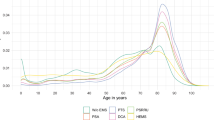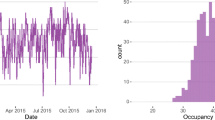Abstract
This article focuses on the Critical Care Unit (CCU) of a large teaching hospital. The aim of the study was to optimise the number of beds available in order to minimise cancellations of Elective surgery and maintain an acceptable level of bed-occupancy. The CCU is where critically ill patients are cared for and often requires one-to-one nursing care. The discrete event simulation model, built in Visual Basic for Applications for Excel, seeks to simulate the bed-occupancy of the CCU as well as monitoring any cancellations of Elective surgery. Several ‘what-if’ scenarios are run including increasing bed numbers, ‘ring-fencing’ beds for Elective patients, reducing length of stay to account for delayed discharge and changing the scheduling of Elective surgery, and the results are reported.



Similar content being viewed by others
References
Cahill W and Redner M (1999). Dynamic simulation modeling of ICU bed availability. In: Farrington PA, Nembhard HB, Sturrock DT and Evans GW (eds). Proceedings of the 1999 Winter Simulation Conference Vol. 2, ACM: New York, pp 1573–1576.
Coats TJ and Michalis S (2001). Mathematical modelling of patient flow through an accident and emergency department. Emerg Med J 18 (3): 190–192.
Costa AX et al (2003). Mathematical modelling and simulation for planning critical care capacity. Anaesthesia 58 (4): 320–327.
Griffiths JD, Price-Lloyd N, Smithies M and Williams JE (2005). Modelling the requirement for supplementary nurses in an intensive care unit. J Opl Res Soc 56 (2): 126–133.
Halpern NA, Pastores SM and Greenstein RJ (2004). Critical care medicine in the United States 1985–2000: An analysis of bed numbers, use, and costs. Crit Care Med 32 (6): 1254–1259.
Kim SC, Horowitz I, Young KK and Buckley TA (1999). Analysis of capacity management of the intensive care unit in a hospital. Eur J Opns Res 115 (1): 36–46.
Kolker A (2009). Process modeling of ICU patient flow: Effect of daily load leveling of elective surgeries on ICU diversion. J Med Syst 33 (1): 27–40.
Litvak N, van Rijsbergen M, Boucherie RJ and van Houdenhoven M (2008). Managing the overflow of intensive care patients. Eur J Opns Res 185 (3): 998–1010.
Lowery JC (1993). Multi-hospital validation of critical care simulation model. In: Evans GW, Mollaghasemi M, Russell EC and Biles WE (eds). Proceedings of the 1993 Winter Simulation Conference. ACM: New York.
Marshall AH and McClean SI (2004). Using Coxian phase-type distributions to identify patient characteristics for duration of stay in hospital. Health Care Mngt Sci 7 (4): 285–289.
Moore S (2003). Capacity planning—modelling unplanned admissions in the UK NHS. Int J Health Care Qual Assur 16 (4): 165–172.
Shahani AK, Ridley SA and Nielsen MS (2008). Modelling patient flows as an aid to decision making for critical care capacities and organisation. Anaesthesia 63 (10): 1074–1080.
Author information
Authors and Affiliations
Corresponding author
Rights and permissions
About this article
Cite this article
Griffiths, J., Jones, M., Read, M. et al. A simulation model of bed-occupancy in a critical care unit. J Simulation 4, 52–59 (2010). https://doi.org/10.1057/jos.2009.22
Received:
Revised:
Published:
Issue Date:
DOI: https://doi.org/10.1057/jos.2009.22




